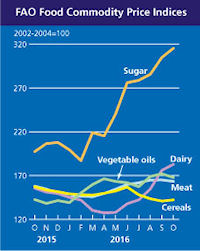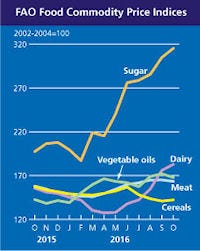FAO Food Price Index, which tracks prices for five groups of foods, has been on the rise throughout this year and is now 9% higher than one year ago.

The U.N. Food & Agriculture Organization (FAO) Food Price Index averaged 172.6 points in October, up 0.7% for the month and 9.1% higher than a year earlier, with the staple grains index rising for the first time in three months.
The Food Price Index, which has risen continuously throughout 2016 except for a brief dip in July, is a trade-weighted index tracking international market prices for five major food commodity groups.

In October, sugar and dairy values rose sharply, while the cereal index made a modest increase. These gains coincided with sharp declines in the oils and meat indices, which kept the overall value of the FFPI only slightly above its September average.
October's rise was driven primarily by jumps in sugar and dairy prices, while the cereal index made a modest increase. These gains coincided with sharp declines in the oils and meat indices, which kept the overall value of the Food Price Index only slightly above its September average.
The FAO Sugar Price Index rose 3.4% in October amid reports of production shortfalls in Brazil's Centre South region and India's Maharashtra state.
The FAO Dairy Price Index rose 3.9% from September, led by rising prices of cheese and, in particular, butter as a result of sustained internal demand in the European Union after a period during which stocks were drawn down. Milk powders recorded more modest increases. “Falling month-on-month milk production in the EU and lower output in Oceania have raised expectations of a likely forthcoming tightening in export supplies and fuelled a price surge in recent months,” the FAO report noted.
By contrast, the FAO price index for oils and fats declined 2.4% from September, largely linked to weaker palm oil quotations as a consequence of sluggish global import demand.
The FAO Meat Price Index averaged 163.4 points in October, down 1.7 points (1% ) from its revised value for September. A decline in EU export prices for pork, stemming from excess domestic supplies and slackening import demand from China, was the principal cause of the decline in this index. Additionally, Oceania beef meat export prices continued to decrease as increased domestic production in the U.S. prevented a need for external supplies. Conversely, Oceania beef meat prices reached their highest level in almost two years due to reduced output in both Australia and New Zealand.
The FAO Cereal Price Index, meanwhile, rose 1% in October, buoyed by tightening supplies of high-quality wheat, even as the overall prospects for global wheat harvests have improved.
A primary driver of increased utilization of cereals is global feed use, which is likely to expand by 2.7%. The use of wheat for animal feed, buoyed by ample supplies of lower-quality wheat, is anticipated to grow by 6.1% to 146.6 million metric tons — an all-time high.
Global food consumption of cereals is forecasted at 1.106 billion mt, up 1.3% from a year earlier and sufficient to maintain a broadly stable per capita consumption level globally. World cereal stocks will likely increase to nearly 662 mmt by the end of the 2017 seasons, driven by growing wheat inventories, especially in China, the U.S. and Russia.
Coarse grains stocks are projected to drop 1.7%, led by reductions in China, Brazil and South Africa. World rice inventories are expected to fall slightly to 169.8 mmt.
About the Author(s)
You May Also Like



.png?width=300&auto=webp&quality=80&disable=upscale)

